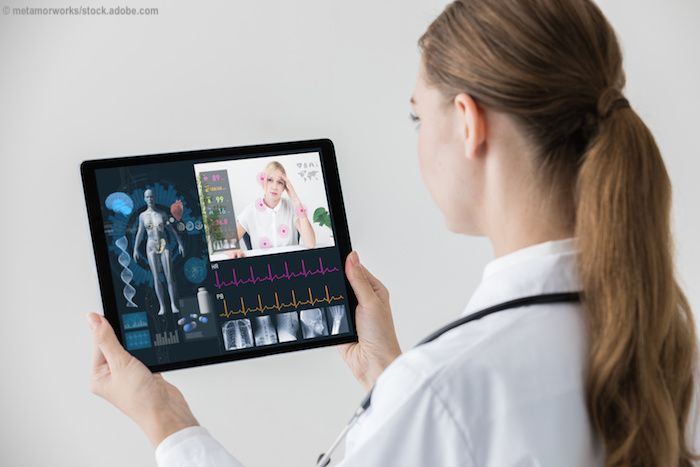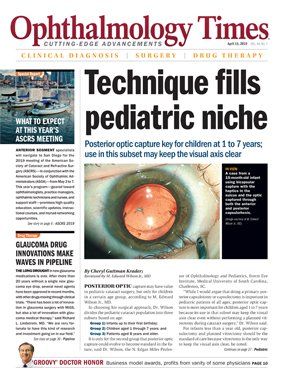Publication
Article
Digital Edition
Telemedicine, teleophthalmology programs in action at Johns Hopkins
Author(s):
Creative disruption of an existing model can be the path forward to a new technology, such as telehealth, a market that has grown rapidly since 2012, and is expected to continue to do so over the next several years.

Artificial intelligence can provide a knowledge base that can be a foundation for the interpretation of data. The importance of the humanistic elements of medicine remain vital.
Creative disruption of an existing model can be the path forward to a new technology, such as telehealth, a market that has grown rapidly since 2012, and is expected to continue to do so over the next several years.
What is telemedicine?
The American Telemedicine Association defines telemedicine as the transfer of medical information via telecommunication (both synchronous and asynchronous) technology or specially designed medical devices for the purpose of delivering healthcare services and clinical information.
In Maryland, where Johns Hopkins University is located, telemedicine is described as the use of interactive audio, video, or other telecommunications or electronic technology by a physician in the practice of medicine outside the physical presence of the patient. Multiple layers make up a telemedicine system-tools and equipment, modes or types of telemedicine, specialty areas of care, individual patients and providers, and the locations where virtual care will be delivered.
Equipment
Both the patient and the clinician need certain tools to perform telemedicine. For the patient these can include a laptop, smartphone, or other personal smart device, equipped with a camera, and the appropriate app or software. In some cases remote monitoring equipment at home can be useful as well. The physician will need similar equipment, plus additional software and peripherals for use in diagnosing disease or progression and reporting results.
Modes
There are three main types of telemedicine, each good for certain uses. Only one of them (synchronous) requires the physician and patient to be available at the same time. Telehealth makes individualized, patient-centric care possible for patients across the continuum of care.
Locations Served
At Johns Hopkins, telemedicine connects the entire healthcare system including community physician practices, all Johns Hopkins’ hospitals, affiliated hospitals, the home-care group, skilled-nursing facilities, and other collaborative facilities.
Challenges
Many challenges remain in using telemedicine, most significant of which include policies and reimbursement.
While the telehealth market continues to grow, telemedicine volumes expand at the speed of reimbursement. Commercial payors have largely embraced telemedicine but government payors (Medicare and Medicaid) have been more reluctant. There has been an uptick in reimbursement for telemedicine services from government payors.
Without appropriate reimbursement, providers will not utilize new technology tools for health care delivery. Direct-to-consumer online virtual care has been more successful with self-pay options. Other notable concerns include obtaining licensing to practice medicine across state lines (a medical license is required in the state where the patient is located), and credentialing and privileging at the originating site.
Telemedicine at Johns Hopkins
The Johns Hopkins Medicine (JHM) Office of Telemedicine, established July 1, 2016, coordinates all telemedicine efforts across the Hopkins healthcare enterprise.
The goals of the JHM system are to:
- Create and increase access for patients
- Expand the populations served
- Lower the total cost of care
- Simplify and streamline the process for physicians
- Ensure compliance
- Embed reporting within the electronic health record
- Maintain quality and safety
- Standardize documentation
- Minimize risk
Telemedicine reduces costs by avoiding unnecessary patient visits and face-to-face consultations with physicians and by replacing clinic visits with less-expensive virtual care. It increases revenue by giving patients greater access to healthcare, expanding patient share capture, and by increasing a facility’s capacity to accommodate referrals and transfers for more appropriate higher-acuity patients.
Johns Hopkins Medicine has launched 44 telemedicine programs, in 31 specialties, for more than 16,700 patient encounters. Another 38 programs are being prepared to launch, with 30 more in the early pipeline stages.
Diving deeper: Teleophthalmology
Ingrid Zimmer-Galler, MD, associate professor of ophthalmology at the Johns Hopkins Wilmer Eye Institute, points out that teleophthalmology has the potential to be a radical transformer of care delivery.
Current teleophthalmology programs include diabetic retinopathy screening; retinopathy of prematurity (ROP) screening; glaucoma screening and disease management; age-related macular degeneration screening and management; anterior segment and ocular adnexal disease’ and remote consultation and remote emergency department (ED) evaluations.
Diabetic retinopathy screening
Diabetic retinopathy screening is one of the first and most beneficial uses of telemedicine in ophthalmology. In the United Kingdom, diabetic retinopathy is no longer the leading cause of vision loss in working age adults in part due to a robust national telemedicine diabetic retinopathy screening (Liew, Michaelides, Bunce. BMJ Open. 2014;4:e004015).
Telemedicine programs allow patients with diabetes to receive appropriate and timely screening for retinopathy so that necessary intervention can be performed when it is most likely to be beneficial.
Telemedicine with photographic documentation for ROP screening offers increased access for neonatal intensive care units where specialty coverage is often limited.
Telemedicine ROP evaluations may become part of the gold standard for diagnosis and monitoring of the disease given the benefits of retinal imaging over traditional retinal drawings.
Need for improved methods
By 2030, nearly 440 million individuals worldwide will have diabetes. It is projected that by 2020 there will be a significant undersupply of ophthalmologists worldwide. The task of detecting and evaluating diabetic retinopathy will create a resource and economic burden to healthcare systems and telemedicine screening programs will be crucial to meet the demand.
The FDA recently cleared the first artificial intelligence system for use in the United States for diabetic retinopathy screening. This is expected to enhance the efficiency of diabetic retinopathy screening as physician review of every image will no longer be necessary.
Emergency department (ED)
Urgent eye problems account for a significant percentage of ED to ED transfers from community hospitals to tertiary care hospitals due to the lack of ophthalmology coverage.
Telemedicine provides an opportunity to use an external high-resolution camera for a video visit and consultation to avoid transferring the patients from one ED to another.
It is anticipated there will be significant opportunity for growth of telemedicine in ophthalmology and those practices flexible enough to embrace it and integrate new technologies will come out ahead. â
Disclosures:
Ingrid Zimmer-Galler, MDE: izimmerg@jhmi.edu
This article was adapted from Dr. Zimmer-Galler’s presentation at the 2018 meeting of the Johns Hopkins’ Wilmer Eye Institute Current Concepts in Ophthalmology in Baltimore. Dr. Zimmer-Galler has no financial interests to disclose.

Newsletter
Don’t miss out—get Ophthalmology Times updates on the latest clinical advancements and expert interviews, straight to your inbox.




